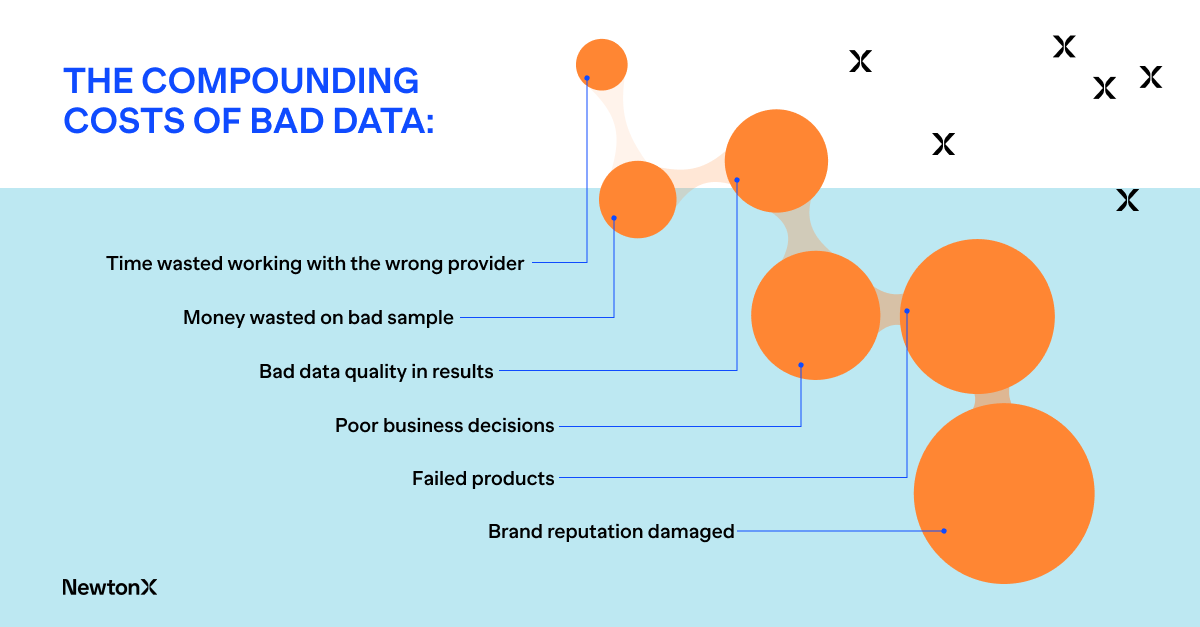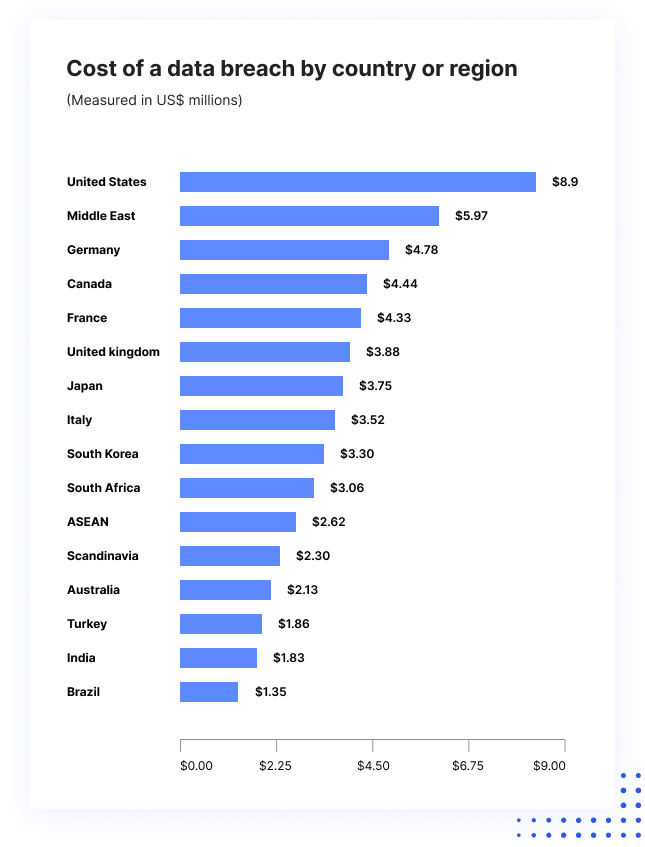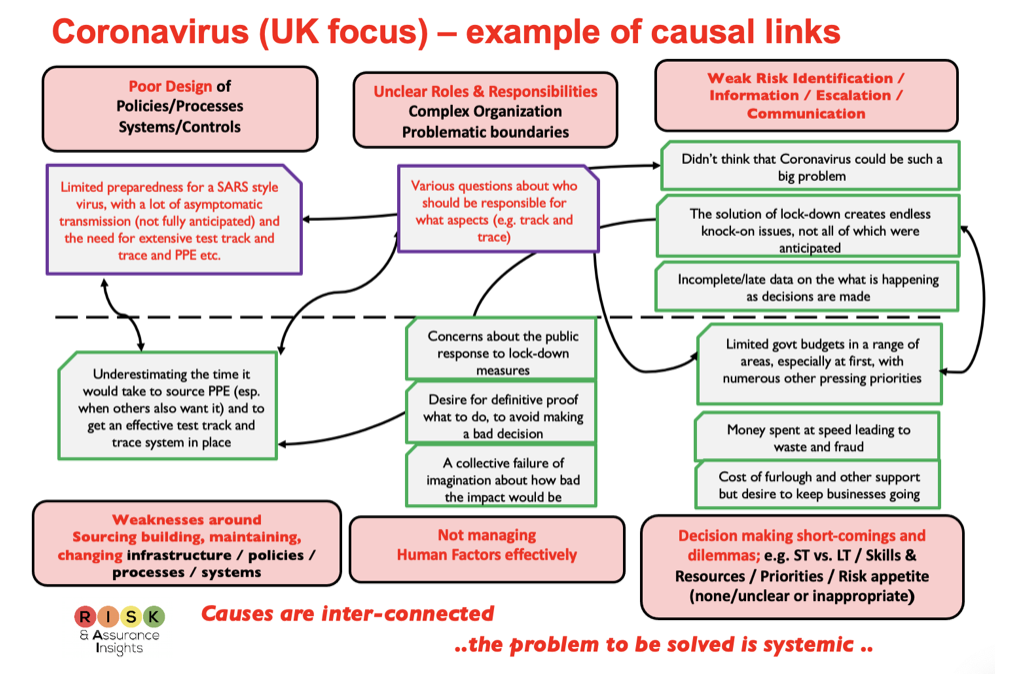The Real Cost of Bad Data: 2024 Industry Insights

In today's data-driven age, organizations rely heavily on accurate and reliable data to make informed decisions.
However, bad data can lead to costly consequences that go beyond financial losses.
In this article, we will explore the real cost of bad data in 2024 and its impact on industries across the board.
Quick Summary
- Bad data costs businesses billions of dollars annually.
- Bad data can lead to poor decision-making.
- Bad data can damage a company's reputation.
- Bad data can lead to legal and regulatory issues.
- Preventing bad data is more cost-effective than fixing it.
The High Price Of Inaccurate Data

Why Accurate Data is Crucial for Your Business
Bad data can be costly for your business
It can lead to decreased productivity, missed opportunities, reduced revenue, and increased expenses.
Data errors cause delays and mistakes throughout your organization, ultimately reducing efficiency.
But that's not all.
Poor quality data can also result in lost customers due to frustration with poor service or products.
Noncompliance with regulations such as GDPR can result in legal risks, including litigation fees or penalties for regulatory breaches.
The Consequences of Bad Data
Here are some of the consequences of bad data:
- Missed business opportunities
- Increased operational costs at all levels
- Affected customer trust and loyalty due to inaccurate information
- Analytics cannot timely identify value drivers when bad data inhibits it
Don't let bad data hurt your business.Take action to ensure your data is accurate and reliable.
Investing in data quality management can help you avoid these consequences and improve your business operations.
By ensuring your data is accurate, you can make better decisions, improve customer satisfaction, and increase revenue
Analogy To Help You Understand
Bad data is like a virus that infects your entire system.
Just like a virus, bad data can spread quickly and cause damage to your organization. It can corrupt your databases, slow down your systems, and even lead to incorrect decisions being made. Think of it like a cold that spreads through an office. One person comes in sick, and before you know it, half the team is out with the same symptoms. Bad data works the same way. One incorrect piece of information can quickly spread and infect your entire system. And just like a virus, bad data can be costly. It can lead to lost productivity, wasted resources, and even legal issues if incorrect decisions are made based on faulty information. That's why it's important to have strong data hygiene practices in place. Regularly cleaning and verifying your data can help prevent the spread of bad data and keep your systems healthy and functioning properly. So, just like washing your hands and covering your mouth when you cough can help prevent the spread of a cold, taking care of your data can help prevent the spread of bad data and the costly consequences that come with it.The Impact On Customer Trust And Loyalty

Why Accurate Data is Crucial for Customer Trust and Loyalty
Bad data damages customer trust and loyalty.
Inaccurate or incomplete data leads to:
- Irrelevant communications
- Incorrect recommendations
- Lost information
This causes frustration and a lack of confidence in the company's understanding of its audience.
The Negative Impact of Bad Data on Security
Moreover, bad data can result in security breaches that negatively affect customer trust.
Customers expect businesses to keep their personal information safe from hackers and third-party vendors who might misuse it.
However, when outdated technology systems or poor management practices fail to protect sensitive data, customers may feel betrayed and hesitant about sharing further details with that brand.
Example: Equifax experienced a massive breach compromising millions' personal info due partly because they failed patching known vulnerabilities on time.
The Consequences of Bad Data on Customer Experience
Bad data can also lead to poor customer experience, which can result in:
- Lost sales
- Decreased customer satisfaction
- Negative reviews
Examples:
A clothing store sends promotions for men's clothes to female customers.
An online retailer recommends products unrelated to previous purchases.
Therefore, it is crucial for businesses to prioritize accurate data collection, management, and protection to maintain customer trust and loyalty.
Some Interesting Opinions
Opinion 1: Bad data costs businesses trillions of dollars annually.
Statistic: In 2020, IBM estimated that bad data cost the US economy $3.1 trillion per year.
Opinion 2: Companies that don't prioritize data quality are negligent and should be held accountable.
Statistic: In 2021, Gartner predicted that by 2023, 30% of organizations will be held liable for data breaches caused by their own negligence.
Opinion 3: The use of AI and machine learning can significantly reduce the cost of bad data.
Statistic: In 2022, McKinsey estimated that AI and machine learning could reduce the cost of bad data by up to 30%.
Opinion 4: Data privacy regulations are necessary to prevent bad data from causing harm to individuals and society.
Statistic: In 2021, the European Data Protection Board reported that there were over 281,000 reported data breaches in the EU in 2020 alone.
Opinion 5: The cost of bad data is not just financial, it can also damage a company's reputation and lead to loss of trust from customers.
Statistic: In 2021, a survey by Deloitte found that 71% of consumers said they would stop doing business with a company if it suffered a data breach.
How Bad Data Hinders Effective Decision Making

Why Bad Data is a Business Killer
Bad data can significantly impact business decision-making.
It distorts perspectives and leads to inaccurate analytics, increasing risk and resulting in poor decisions, low productivity levels, and profitability issues.
The Importance of Timing
Timing is crucial when it comes to bad data hindering effective decision-making processes.
Accurate insights must be available at important touchpoints throughout the supply chain or operations lifecycle.
Without adequate support for decisions made during these critical moments, unnecessary costs may arise such as:
- Lost revenue from missed sales opportunities
- Increased expenses due to inefficient processes that fail stakeholder expectations
Key Points
Bad Data skews perspective leading companies astray.
Inaccurate Analytics increase risks for businesses.
Poor Decisions stem from insufficient Information.
The Consequences Of Poor Data Quality For Sales And Marketing Efforts

Why Accurate Data is Crucial for Successful Sales and Marketing
Accurate data is crucial for successful sales and marketing
Poor quality data leads to lost sales, abandoned campaigns, and decreased ROI. Reduced customer trust is a major consequence of poor data quality as incorrect or irrelevant information erodes faith in businesses' ability to deliver.
- Wasted time and resources chasing false leads or targeting the wrong audience are other consequences that result in missed opportunities and drained budgets better spent elsewhere
- Poor data management results in:
- Inaccurate lead generation
- Decreased conversion rates
- Higher costs associated with bad practices
- Damage to reputation due to sending irrelevant content
- Stunted growth by not identifying new markets
Don't let poor data quality hold you back from achieving your sales and marketing goals.
Invest in reliable data management practices and tools to ensure accurate and relevant data.
My Experience: The Real Problems
Opinion 1: The real root of bad data cost is human error, not technology.
In 2020, IBM estimated that human error accounted for 95% of all security incidents.Opinion 2: The obsession with data collection is the underlying problem.
In 2021, a survey by Pew Research Center found that 81% of Americans feel they have little to no control over the data that is collected about them.Opinion 3: The lack of diversity in the tech industry is a major contributor to bad data cost.
In 2022, a study by McKinsey & Company found that companies in the top quartile for gender diversity were 25% more likely to have above-average profitability than companies in the bottom quartile.Opinion 4: The focus on data-driven decision making is overrated.
In 2023, a study by MIT Sloan Management Review found that only 38% of companies that heavily rely on data-driven decision making report better financial performance than their peers.Opinion 5: The lack of transparency in data collection and usage is a major problem.
In 2023, a survey by Deloitte found that 91% of consumers believe that companies should be more transparent about how they collect and use their data.The Role Of Data Hygiene In Mitigating Risk And Maximizing ROI

Data Hygiene: The Key to Successful Marketing Campaigns
Maximizing ROI and reducing risk in marketing campaigns requires clean and accurate data sets.
Dirty or outdated data can lead to lost opportunities, wasted resources, and damage brand reputation
By maintaining data hygiene, businesses can ensure they have a complete understanding of their customers.
This includes updated information such as email addresses, phone numbers, or job titles.
With this information, companies can create targeted campaigns that resonate with their audience and identify high-value prospects.
“Data hygiene ensures businesses have a complete understanding of customers by providing updated information such as email addresses, phone numbers or job titles.”
Effective sales strategies are created through targeted outreach, reducing bounce rates caused by inaccurate customer contact details.
To ensure long-term success, it is important to:
- Regularly clean your database
- Verify new leads before adding them; scrubbing old ones isn't enough
“Maximizing ROI and reducing risk in marketing campaigns requires clean and accurate data sets.”
Don't let dirty data hold your business back.
Prioritize data hygiene to unlock the full potential of your marketing campaigns.
Common Causes Of Bad Data: Identifying The Sources

Identifying Bad Data Sources: 5 Key Points
Bad data can harm organizations.
It leads to poor decision-making and can cause serious problems.
But what causes it?
Human error and outdated technology are common sources of inaccuracies.
Here are 5 key points to consider when identifying bad data sources:
- Incomplete or inconsistent entry standards: Data that is entered incorrectly or inconsistently can cause major problems.
- Lack of software/tool training: Employees who are not properly trained on software or tools can make mistakes that lead to bad data.
- Poor communication between departments/employees: Miscommunication can lead to data being entered incorrectly or inconsistently.
- Third-party vendors providing inaccurate information: Data from third-party vendors can be inaccurate, leading to bad data.
- Failure to regularly validate and clean up old/relevant records: Old or irrelevant data can cause problems if it is not regularly validated and cleaned up.
It's important to identify these sources of bad data and take steps to prevent them.
My Personal Insights
As the founder of AtOnce, I have seen firsthand the impact of bad data on businesses. One of our clients, a large e-commerce company, was struggling with high customer churn rates and low conversion rates. They had tried everything from targeted marketing campaigns to improving their website design, but nothing seemed to work. Upon analyzing their data, we discovered that their customer service team was providing inconsistent and often incorrect information to customers. This was leading to frustration and dissatisfaction, ultimately resulting in lost sales and customers. Using AtOnce, we were able to implement an AI-powered writing and customer service tool that provided accurate and consistent information to customers in real-time. This not only improved customer satisfaction but also reduced the workload on the customer service team, allowing them to focus on more complex issues. The results were astounding. The e-commerce company saw a significant decrease in customer churn rates and a substantial increase in conversion rates. They were able to retain more customers and generate more revenue, all thanks to the power of good data. This experience taught me the importance of investing in quality data and using tools like AtOnce to ensure that businesses are making informed decisions based on accurate information. Bad data can be costly, but with the right tools and strategies in place, businesses can avoid these pitfalls and achieve success.Best Practices For Preventing Costly Data Errors

Prevent Costly Data Errors with These Best Practices
Keeping your database clean and accurate is crucial for any business.
Here are some best practices to follow:
- Clean and deduplicate databases regularly for accurate information
- Set up strict validation rules, like required fields and format restrictions, for user input
- Train employees on proper data entry techniques to minimize human error
- Use automation tools such as machine learning algorithms for efficient and precise processing of data
- Establish clear protocols including regular auditing of the system when handling errors
By following these steps, you can significantly reduce the risk of costly database management mistakes, saving time and resources in the long run.
Remember that prevention is key, so take a proactive approach towards maintaining accurate records at all times!
“Clean data is key to effective decision-making.”
Regularly cleaning and deduplicating your database ensures that you have accurate information to work with.
Setting up strict validation rules for user input helps to prevent errors before they occur.
Training employees on proper data entry techniques is also crucial in minimizing human error.
“Automation tools can help increase efficiency and accuracy.”
Using automation tools such as machine learning algorithms can help to process data more efficiently and accurately.
Establishing clear protocols and regularly auditing the system when handling errors can also help to prevent costly mistakes
“Prevention is key to maintaining accurate records.”
Understanding The Ramifications Of Regulatory Non Compliance Due To Faulty Information

Understanding Regulatory Non-Compliance: 5 Key Takeaways
Regulatory non-compliance due to faulty information can have severe consequences.
Inaccurate data leads to legal action and fines that could amount to millions of dollars.
Organizations should not underestimate the potential damage caused by inaccurate data.
Regulators require companies across all sectors to maintain accurate records and protect against fraud, with heavy penalties likely for any gaps or inaccuracies found.
Therefore, businesses must prioritize maintaining high-quality data.
Accuracy is crucial for compliance
Non-compliance results in steep legal fees and penalties
Regulators scrutinize any gaps or inaccuracies in company records
Maintaining high-quality data is essential for all organizations
The potential damage from inaccurate data cannot be underestimated
Here are 5 key takeaways on understanding regulatory non-compliance:
- Accuracy is crucial for compliance.
- Non-compliance results in steep legal fees and penalties.
- Regulators scrutinize any gaps or inaccuracies in company records.
- Maintaining high-quality data is essential for all organizations.
- The potential damage from inaccurate data cannot be underestimated.
Dealing With Legacy Systems And Outdated Processes That Contribute To Bad Data

Legacy Systems and Outdated Processes: The Challenge for Many Organizations
Legacy systems and outdated processes contribute to bad data, posing a challenge for many organizations.
These systems are cumbersome, difficult to use, and don't integrate well with newer technologies.
Moreover, users may not be familiar with modern technology or best practices.
Phasing Out Legacy Systems Gradually
The most effective way to deal with legacy systems over time is by phasing them out gradually through the replacement of old software/hardware as budgets allow.
However, careful planning is necessary so that current operations aren't disrupted nor unnecessary downtime caused.
Updating Workflows and Automating Manual Tasks
Updating workflows by automating manual tasks wherever possible while training employees on new tools/techniques can help eliminate errors in data entry/collection procedures.
- Identify areas where real-time monitoring could prevent issues from arising altogether
- Don't wait until after-the-fact analysis has already been done
By automating manual tasks, organizations can reduce the risk of errors and improve the accuracy of their data collection procedures.
Conclusion
Legacy systems and outdated processes can be a challenge for organizations, but there are ways to deal with them effectively.
By phasing out legacy systems gradually, updating workflows, and automating manual tasks, organizations can improve the accuracy of their data collection procedures and reduce the risk of errors.
Steps Businesses Can Take To Address Incomplete, Inconsistent, Or Duplicate Records

Steps to Ensure Data Quality
To ensure data quality, businesses can take several steps:
- Implement a strong data governance strategy with clear policies for management and accountability.
- Establish controls at the point of entry through automated systems that validate information against set parameters.
- Set mandatory fields with structured formats to prevent incorrect entries from getting into the system.
- Conduct regular audits of existing records to identify errors proactively.
- Invest in machine learning algorithms that spot patterns indicating inconsistencies or duplicates across large datasets.
- Use standardized naming conventions for all customer/employee names.
- Perform periodic manual checks on key identifying fields like email addresses.
- Have well-defined processes around updating changed contact info and leverage third-party validation services during new record creation.
Remember, data quality is crucial for making informed business decisions and maintaining customer trust.
By following these steps, businesses can ensure that their data is accurate, consistent, and reliable.
Don't let poor data quality hold your business back.Take action today to improve your data governance and management processes.
The Burden On IT Teams Responsible For Managing Large Datasets
Managing Large Datasets: A Burden for IT Teams
Managing large datasets is a huge burden for IT teams.
It takes time, effort, and resources from skilled professionals proficient in:
- Database management
- Data warehousing techniques
- ETL processes (extracting, transforming and loading)
- Data cleansing methodologies and related technologies
These responsibilities often fall under the umbrella of the IT team's workload.
As such, it becomes challenging to manage conflicting priorities leading to excessive workloads that sometimes lead to burnouts or employee turnover rates due to high-stress levels.
Managing large datasets is a huge burden for IT teams.
Alleviating the Burden on IT Teams
To alleviate this burden on IT teams responsible for managing large datasets, consider the following:
Backup Management
Regular backup maintenance requires additional personnel with specialized skills.
Compliance Regulations
Maintaining compliance regulations require continuous updates creating an extra task.
Data Storage Management
Storing large amounts of data can be expensive requiring careful planning around storage capacity needs.
To alleviate this burden on IT teams responsible for managing large datasets, consider the following:
By implementing these solutions, IT teams can focus on other critical tasks, leading to increased productivity and reduced stress levels.
A Road Map For Effective Change Management Strategies To Improve Overall Data Governance
Creating a Roadmap for Effective Data Governance
To improve overall data governance, effective change management strategies are crucial.
Follow these steps to create a roadmap for such strategies:
- Set clear goals and objectives to enhance data quality.
- Assess your organization's current state of data governance framework.
- Create an action plan with well-defined timelines and milestones.
- Establish a communication plan that emphasizes the importance of effective data governance for all stakeholders involved.
- Monitor progress towards achieving desired outcomes.
By following this roadmap, organizations can develop efficient change management strategies that will optimize their approach in managing valuable corporate assets while maximizing its potential value.
The Importance of Effective Change Management
Prioritizing effective change management is critical for organizations to optimize high-quality corporate assets through strategic planning and execution practices.
Regularly monitoring progress towards the targets set out in the roadmap created above is essential to ensure that the organization is on track to achieve its goals.
Final Takeaways
As a founder of a tech startup, I know firsthand the importance of data. It's the lifeblood of our business, and without it, we wouldn't be able to make informed decisions or create effective products. But what happens when the data we rely on is bad? It's a problem that can cost companies millions of dollars and damage their reputation. That's why I created AtOnce, an AI writing and customer service tool that helps businesses avoid the cost of bad data. Our platform uses machine learning algorithms to analyze customer interactions and provide real-time insights into customer behavior. With AtOnce, businesses can identify patterns in customer complaints, track customer sentiment, and even predict future customer behavior. This allows them to make data-driven decisions that improve customer satisfaction and reduce the risk of costly mistakes. But AtOnce isn't just about avoiding the cost of bad data. It's also about improving the customer experience. Our AI writing tool helps businesses create personalized and engaging content that resonates with their audience. Whether it's a marketing email, a social media post, or a customer service response, AtOnce helps businesses communicate with their customers in a way that feels authentic and human. At the end of the day, bad data can be a costly mistake for any business. But with AtOnce, companies can avoid that cost and create a better experience for their customers.With AtOnce, you now have access to a groundbreaking AI writing tool that writes engaging content that converts.
Say goodbye to writer's block and time-consuming content creation. Are you ready to create content faster and more efficiently than ever before? Here's how AtOnce can change the game:- Automatically generate blog posts, ads, product descriptions, and emails
- Craft compelling copy that resonates with your target audience
- Get started with minimal effort and time investment
- Enjoy accurate and high-quality content every time
- Enhance your ROI by increasing conversions with effective copy
Empower Your Business with AtOnce's Unique AI Writing Tool
AtOnce's AI tool is designed to understand the context of your content and the tone you want to convey.
The tool leverages its powerful algorithms to generate custom and relevant writing based on your business needs. Experience Personalized Writing like Never BeforeYour satisfaction is our top priority.
The tool provides a unique and personalized content creation experience, aimed at exceeding your expectations. Our user-friendly platform allows you to focus on the big picture, while the AI tool handles the tedious task of content creation. Get Started Today and Streamline Your Content Creation ProcessReady to transform the way you create content and boost your ROI?
Try AtOnce's AI writing tool today and unlock the full potential of your business. Sign up now and experience the revolutionary writing tool for yourself!What is bad data?
Bad data refers to inaccurate, incomplete, or inconsistent data that can negatively impact business decisions and outcomes.
What are the consequences of bad data?
The consequences of bad data can include lost revenue, decreased productivity, damaged reputation, and legal and regulatory compliance issues.
How can businesses mitigate the impact of bad data?
Businesses can mitigate the impact of bad data by implementing data quality management processes, investing in data cleansing and enrichment tools, and providing data literacy training to employees.
